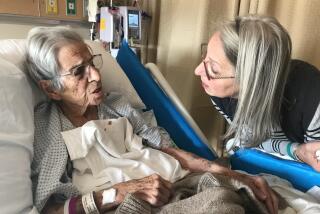Nursing Crisis Is a Threat to Health
- Share via
Anyone who has watched a hospitalized child, parent or friend pound uselessly on a call button understands the problem: As nurses have to care for more and sicker people, the death and accident rate among patients goes up.
For years, however, as nurses complained about the harm to patients from staff cuts, hospital managers and executives dismissed such worries as “anecdotal” or as disguised complaints about increased workloads.
Finally, research has proved the nurses resoundingly correct.
In this week’s Journal of the American Medical Assn., prominent nursing and medical researchers confirm the risks to patients of overburdening nurses.
This study of more than 200,000 surgical patients and 10,000 nurses documents the link between nurse staffing and increased risk of patients dying after surgery, as well as with increased nurse burnout and job dissatisfaction.
The report also proposes serious solutions modeled on a safe-staffing law passed in California in 1999. (The law is not scheduled to go into effect until January 2004, in part because of heavy pressure for delay from hospitals.)
Stopping the epidemic of deaths and injuries to hospitalized patients and resolving the nursing shortage are now spoken of as national priorities, but most of the political solutions being proposed ignore the underlying problems laid bare by this and other recent studies.
Investigators for the latest study found that when nurse caseloads exceeded four patients, the risk of a patient’s dying increases by about 7% per extra patient. If one nurse is caring for eight patients, the patients are 31% more likely to die.
Plus, each extra patient added to the nurses’ caseloads increases job dissatisfaction and the likelihood that burnout will push them out of nursing altogether.
Another recent study found that fewer nurses meant that patients suffered from more urinary tract infections, falls and bedsores and contracted pneumonia more often.
In August, the Joint Commission on the Accreditation of Health Care Organizations found that inadequate nurse staffing levels contributed to nearly a quarter of the 1,609 cases of accidental injury or death documented for hospitalized patients since 1997.
Even faced with such alarming numbers, legislators in most states and in Congress have refused to pass tough staffing regulations or limit hospital requirements that nurses work overtime to make up for staff shortfalls.
With great fanfare, Congress instead passed the Nurse Reinvestment Act.
This act will, among other things, provide money for scholarships to try to entice more people into nursing and give hospitals resources to recruit new nurses. Many states are taking similar action.
The problem is that the measure, yet to be funded, and its state clones do not deal seriously with hospital working conditions.
By focusing on the production of a new crop of nurses, they merely install another revolving door in hospitals that nurses are trying to flee.
Hospitals argue that safe-staffing laws like California’s and bans on mandatory overtime won’t work because, try as they might, they just can’t find enough nurses to fill their units. But making hospitals friendly to nurses is the only way to make nursing a satisfying career.
When hospitals stop treating nurses as cheap, disposable labor -- and in the process exposing patients to unnecessary risks -- then recruitment will pay off.
Think of it this way: When a patient is hemorrhaging, the first thing the medics do is find the source of the bleeding and try to stem the flow. Then they give the patient a transfusion. If a transfusion is given while a patient continues to hemorrhage, the person’s color may improve, and doctors and nurses may feel they’ve “done something,” but the patient will still bleed to death.






